by David Clarke | Jul 31, 2012 | All, Insects & Spiders, Italy
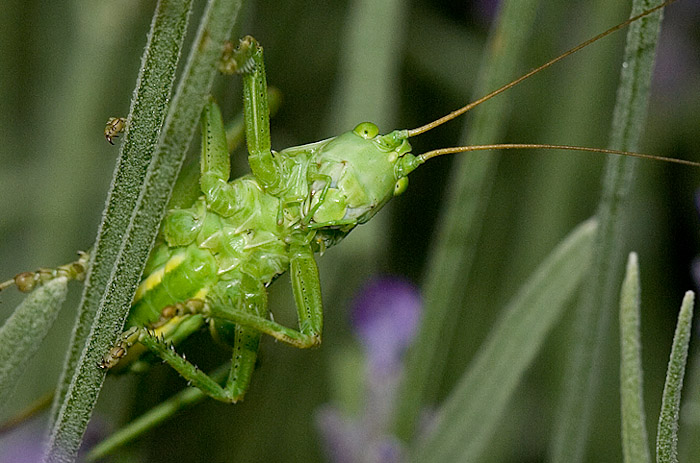
This inquisitive grasshopper was prowling the lavender, doing whatever grasshoppers do, when he spotted me and froze. Perhaps he was checking out the long lens.
Canon 1D MKII with Canon 300mmL f2.8 IS lens and Canon 12mm tube. ISO 200 1/200 at f8
by David Clarke | Jul 29, 2012 | All, Flowers, Italy
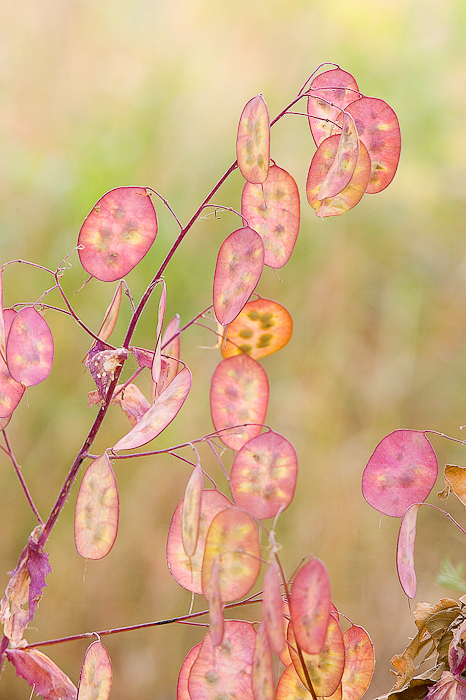
Honesty (Lunaria annua) is a fairly common wildflower in temperate climates. A pretty purple flower, it really comes into its own when the papery seed pods form. It is also known as White Satin, Satin Flower, Money Plant, Silver Plate and Two-Pennies-in-a-Purse. According to wildaboutwildflowers.co.uk, the folklore surrounding it is that for sorcerers, the plant aided shape-changing, flying, finding lost property, unlocking secrets and bringing the dead back to life. It was also used in witches brews and also to dress wounds and treat epilepsy. In Tudor times, the roots were boiled and eaten with meat or grated into salads, while the Victorians painted the seed pods for winter decoration in their homes.
We’ve certainly found that the dried pods are a lovely decoration in a vase indoors, but as for flying, I’m clearly missing something out of the recipe!
The abundance of honesty is our garden varies enormously: some years there is loads in the wooded parts; other years there is very little. However, it is always pretty, even when in an advance state of decay, as shown in the black and white images on the Gallery and Showcase pages.
by David Clarke | Jul 28, 2012 | All, Italy, People
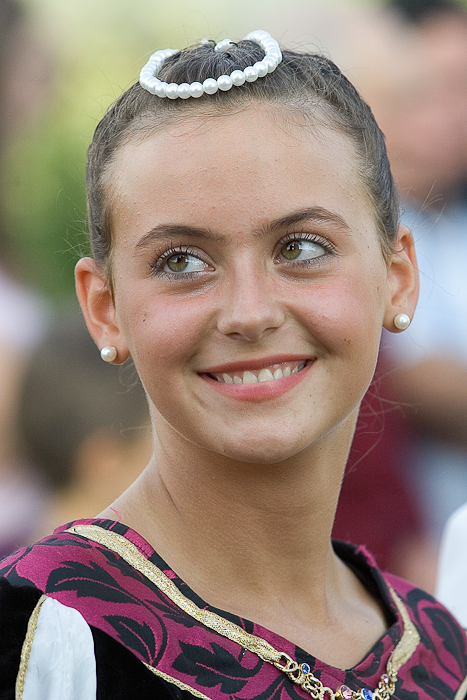
Montecchio is a village in Tuscany on the road between Castiglion Fiorentino and Cortona. As a village, you’d drive through it without noticing it, but up on a hill behind is a medieval castle that opens its doors once a year in September for a medieval pageant lasting two days. It’s a very local affair, attracting people from all over the surrounding area. As well as the main players such as members of the procession, knights, maidens, flag throwers, trumpters etc, there are stall-holders also dressed up in medieval costume preparing traditional doughs as well as the ubiquitous pastas.
This beautiful maiden was part of the main procession that wound its way up from outside the castle and through the grounds, passing trumpeters blowing fanfares, and culminating in a formal ceremony prior to jousts and flag throwing. The wonderful thing about Tuscany is that when the people dress up in the costumes of 500 years ago, they are look like they have stepped out of a renaissance fresco – all the facial features are there.
Canon 1DMkII with Canon 70-200mm f2.8 lens at 190mm; ISO 200 f4.5 1/500
by David Clarke | Jul 27, 2012 | All, Insects & Spiders, Italy
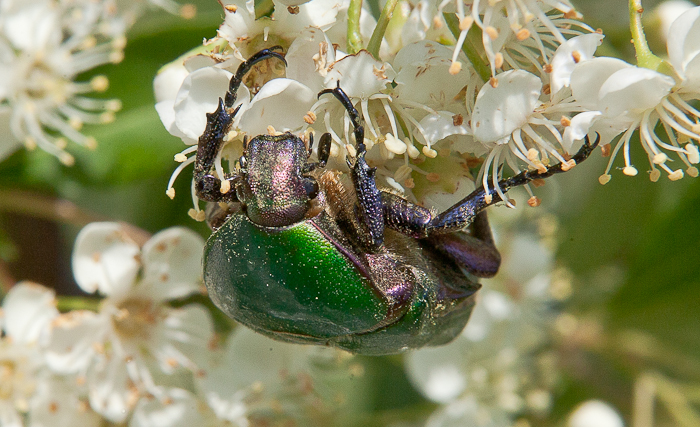
In late May, the pyracanthus ‘Soleil d’Or’ in our garden in Tuscany was in full bloom and alive with insects. Among the invading horde buzzing around me as I approached with my camera was this vivid green beetle who was feasting in delight on the abundance of delicious pollen. It was fascinating to watch it and its companions making their way among the flowers, with legs sticking out in all directions grasping a petal here and a leaf their in order to maintain balance. He is called a rose chafer (Cetonia aurata), the distinctive feature being the small triangular area between the wing cases just below the thorax.
According to Mr Wikipedia, ‘rose chafers are found over southern and central Europe and the southern part of the UK where they seem to be sometimes very localized. They are a very beneficial saprophagous species (detritivore), their larvae are the insect equivalent of earth worms and help make very good compost where they are often found in great numbers.’
Canon 1DMkII with Canon 70-200mm f4L IS lens at 70mm and Canon EB12 tube; ISO400 f16 1/320. Cropped and adjusted in Lightroom
by David Clarke | Jul 26, 2012 | All, Kenya, Places
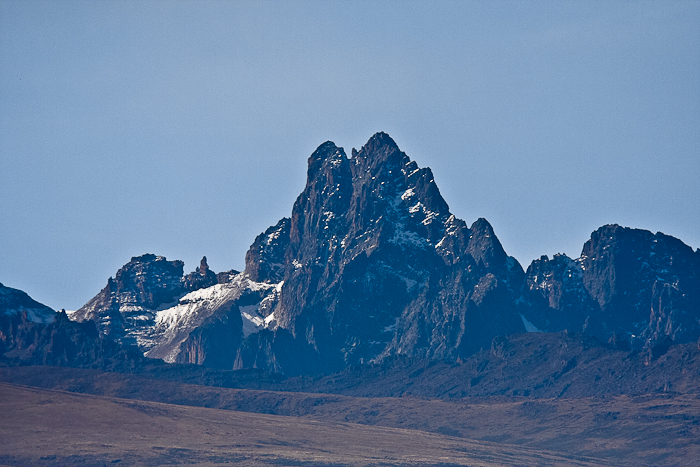
Mount Kenya is very rugged and staggering beautiful, its aspect changing dramatically as your viewpoint changes. This shot is taken from near Timau looking south-south-east towards the mountain, the higher of the two peaks – Bastian – being about twenty miles away. The view is ever-changing as clouds and mist role in and away, as snow falls around the peak and as the light and shadows alter throughout the day. From this viewpoint, the sheerness of the peaks is very vivid.
Mr Wikipedia has this to say (in part) about the mountain (but for more, google Mount Kenya and you will find a wealth of info):
Mount Kenya is the highest mountain in Kenya and the second-highest in Africa, after Kilimanjaro. The highest peaks of the mountain are Batian (5,199 metres (17,057 ft)), Nelion (5,188 metres (17,021 ft)) and Point Lenana (4,985 metres (16,355 ft)). Mount Kenya is located in central Kenya, just south of the equator, around (150 kilometres (93 mi)) north-northeast of the capital Nairobi. Mount Kenya is the source of the name of the Republic of Kenya.
Mount Kenya is a stratovolcano created approximately 3 million years after the opening of the East African rift. It was covered by an ice cap for thousands of years. This has resulted in very eroded slopes and numerous valleys radiating from the centre. There are currently 11 small glaciers. The forested slopes are an important source of water for much of Kenya.
There are eight vegetation bands from the base to the summit. The lower slopes are covered by different types of forest. Many species are endemic to Mount Kenya such as the lobelias, the senecios and the rock hyrax. An area of 715 square kilometres (276 sq mi) around the centre of the mountain was designated a National Park and listed as a UNESCO World Heritage Site in 1997. The park receives over 15,000 visitors per year.
Canon 1DMkII with Canon 300mm L IS lens and Canon 1.4 extender. ISO320 1/5000 at f4.5








